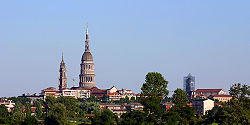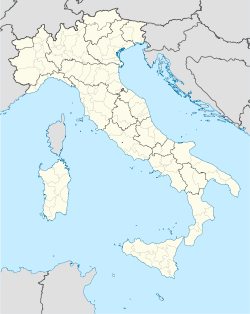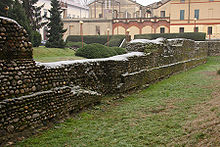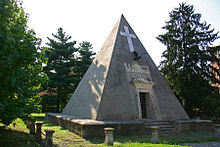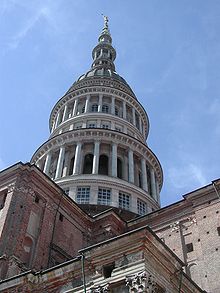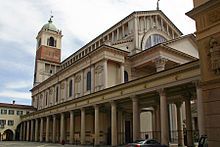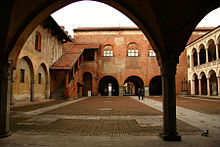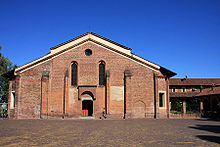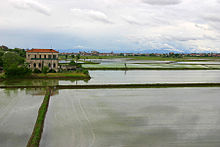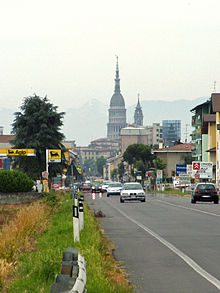- Novara
-
Novara — Comune — Comune di Novara view of Novara 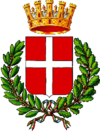
Coat of armsLocation of Novara in Italy Coordinates: 45°27′N 08°37′E / 45.45°N 8.617°E Country Italy Region Piedmont Province Novara (NO) Frazioni Lumellogno, Olengo, Pernate, Torrion Quartara, Agognate, Casalgiate, Cascina Montà, Cascina Roggia Mora, Gionzana, Pagliate Government - Mayor Andrea Ballarè (Democratic Party) Area - Total 103 km2 (39.8 sq mi) Elevation 162 m (531 ft) Population (31 December 2010) - Total 105,024 - Density 1,019.7/km2 (2,640.9/sq mi) Demonym Novaresi Time zone CET (UTC+1) - Summer (DST) CEST (UTC+2) Postal code 28100 Dialing code 0321 Patron saint Saint Gaudentius Saint day January 22 Website Official website Novara
 listen (help·info) (Nuàra in the local dialect) is the capital city of the province of Novara in the Piedmont region in northwest Italy, to the west of Milan. With c. 105,000 inhabitants, it is the second most populous city in Piedmont after Turin. It is an important crossroads for commercial traffic along the routes from Milan to Turin and from Genoa to Switzerland. Novara lies between the rivers Agogna and Terdoppio in northeastern Piedmont, 50 km from Milan and 95 km from Turin.
listen (help·info) (Nuàra in the local dialect) is the capital city of the province of Novara in the Piedmont region in northwest Italy, to the west of Milan. With c. 105,000 inhabitants, it is the second most populous city in Piedmont after Turin. It is an important crossroads for commercial traffic along the routes from Milan to Turin and from Genoa to Switzerland. Novara lies between the rivers Agogna and Terdoppio in northeastern Piedmont, 50 km from Milan and 95 km from Turin.Contents
History
Novara was founded in ancient times by the Romans. Its name is formed from Nov, meaning "new", and Aria, the name the Cisalpine Gauls used for the surrounding region.
Ancient Novaria, which dates to the time of the Ligures, was a municipium and was situated on the road from Vercellae (Vercelli) to (Mediolanum) Milan. Its position on perpendicular roads (still intact today) dates to the time of the Romans. After the city was destroyed in 386 by Magnus Maximus for having supported his rival Valentinian II, it was rebuilt by Theodosius I. Subsequently, it was sacked by Radagaisus (in 405) and Attila (in 452).
Under the Lombards, Novara became a duchy; under Charles the Fat, a countship. Novara came to enjoy the rights of a free imperial city. In 1110, it was conquered by Henry V and destroyed, but in 1167 it joined the Lombard League. At the end of the 12th century, it accepted the protection of Milan and became practically a dominion of the Visconti and later of the Sforza. In the Battle of Novara in 1513, Swiss mercenaries defending Novara for the Sforzas of Milan routed the French troops besieging the city. This defeat ended the French invasion of Italy in the War of the League of Cambrai.
In 1706, Novara, which had long ago been promised by Filippo Maria Visconti to Amadeus VIII of Savoy, was occupied by Savoyard troops. With the Peace of Utrecht, the city, together with Milan, became part of the Habsburg Empire. After its occupation in 1734, Novara passed, in the following year, to the House of Savoy.
After Napoleon's campaign in Italy, Novara became the capital of the Department of the Agogna, but was then reassigned to the House of Savoy in 1814. In 1821, it was the site of a battle in which regular Sardinian troops defeated the Piedmontese constitutional liberals. In the even larger Battle of Novara in 1849, the Sardinian army was defeated by the Austrian army of Field Marshal Joseph Radetzky von Radetz. This defeat led to the abdication of Charles Albert of Sardinia and to the partial occupation of the city by the Austrians. The defeat of the Sardinians can be seen as the beginning of the Italian unification movement.
A decree in 1859 created the province of Novara, which then included the present-day provinces of Vercelli, Biella, and Verbano-Cusio-Ossola.
The city of Novara had a population of 25,144 in 1861. Industrialisation during the 20th century brought an increase in the city's population to 102,088 in 1981. The city's population has changed little in subsequent years.
Oscar Luigi Scalfaro, former president of Italy and Italian senator for life, was born in Novara in 1918.
Main sights
Novara's sights can be divided into two groupings. The city's most important sights lie within its historic centre, the area once enclosed by the city walls. However, several important sights also lie outside the line of the former city walls.
Historic centre
The old urban core makes up the "Historic centre", situated in the district of the same name. Novara once had an encircling wall, which was demolished to permit urban development. Of the old wall there remains only the Barriera Albertina, a complex of two neo-classical buildings that constituted the gate of entry to the city, the required passageway for those who traveled from Turin to Milan. After their removal, the walls were replaced by the present-day baluardi, the broad, tree-lined boulevards that surround the Historic Centre.
The most imposing monument in the city is the Basilica of San Gaudenzio, with a cupola 121 metres in height, designed by Alessandro Antonelli and constructed in 1888. The bell tower is also of particular interest; it was designed by Benedetto Alfieri, uncle of the more famous Vittorio Alfieri.
The centre of the religious life of the city is the Novara Cathedral, in the neo-classical style, also designed by Alessandro Antonelli. It rises exactly where the temple of Jupiter stood in the time of the Romans. Facing the Duomo is the oldest building in Novara today: the early Christian Battistero (Baptistry).
Close to the Duomo is the courtyard of the Broletto (the historic meeting place of the city council), the centre of the political life of the imperial free city of Novara. Overlooking the courtyard of the Broletto are the Palazzo del Podestà ("Palace of the Podestà"), Palazzetto dei Paratici ("Little Palace of the Paratici Family"), site of the Civic Museum and of the Gallery of Modern Art, the Palace of the City Council, and a building of the 15th century.
Not far from the Piazza della Repubblica (formerly Piazza Duomo) is the Piazza Cesare Battisti (known to Novaresi as the Piazza delle Erbe, "Herbs square"), which constitutes the exact centre of the city of Novara.
In Piazza Giacomo Matteotti stands the Palazzo Natta-Isola, seat of the province and of the prefecture of Novara. The landmark feature of this palace is its clock tower. Extending from this square is the via Fratelli Rosselli, along which is the Palazzo Cabrino, the official seat of the administrative offices of the city. As it was a Roman city, the street network of Novara is characterized by a cardo and a Decumanus Maximus, which correspond respectively to the present-day Corso Italia and Corso Cavour. The two streets cross at the so-called "Angolo delle Ore" (Corner of the Hours).
The largest square is Piazza Martiri della Libertà (formerly Piazza Castello) dominated by the equestrian statue of Victor Emmanuel II, the first king of Italy. Overlooking the Piazza Martiri are the Castello Visconteo-Sforzesco, built by the Milanese dukes Visconti and Sforza, and the Teatro Coccia. The Castello Visconteo-Sforzesco, once much larger than the complex that remains today, is surrounded by the Allea, one of the largest public gardens in Novara.
Other important squares are:
- Largo Cavour, dominated by the statue of the same name, recently restored.
- Piazza Garibaldi, the square facing the Novara Railway Station, also recently restored and featuring the statue of the hero of two worlds and by a fountain.
- Piazza Gramsci, formerly Piazza del Rosario, location, after the restoration of 2005, of the landmark statue of Icarus.
Outside of the Baluardi
Places of interest situated outside of the belt of the baluardi include the Church of San Nazzaro della Costa, with its attached abbey, restored in the 15th century by Bernardino of Siena, and the Ossuary of Bicocca, in pyramidal form, which stands in the neighbourhood of Bicocca, in memory of the fallen soldiers of the historic battle of 23 March 1849, between the Piedmontese (Sardinia) and Austrians. Worthy of note are the Church of Santa Maria delle Grazie (Saints Martino and Gaudenzio), built beginning in 1477 by the Augustinians, whose interior consists of a single nave with lateral chapels and paintings attributed to artists of the 15th century, among them Daniele de Bosis.
Festivals and events
- On 22 January of every year, Novara celebrates the Feast of San Gaudenzio (Saint Gaudentius of Novara), the patron saint of Novara. Throughout the day, it is possible to visit the tomb of the saint and to obtain the typical roasted chestnuts, also known as marroni di Cuneo (" Cuneo chestnuts").
- 23 March: Re-enactment of the 1849 Battle of Novara, with period uniforms and weapons.
- On 25 April, Liberation Day, as in many other Italian cities, the Novaresi organise numerous initiatives to commemorate the Italian resistance movement, and in particular, the partisans who fought around Novara and in the "Partisan Republic of the Ossola".
- Since 2001, Giovani Espressioni ("Young Expressions") has been held in Novara. This is a musical festival for emerging young musicians, organised by Staff Millennium, a performance agency, of which Alessandro Marchetti is the artistic director. The "Espressioni Contest" is of special importance as a showcase for emerging bands that picks a winner every year. Among the noted artists who have participated are Negramaro, Caparezza, Finley, Vallanzaska, Extrema, and Blaze Bailey.
- Since 2005, Novara hosts the "Novara Gospel Festival", that is composed by workshops, local tours, and obviously gospel concerts in the main theatre of the city. It is probably one of the most important festival of this music in Italy, also because the main event is a concert of the most appreciated gospel's singers, such as Kirk Franklin, Donnie Mc Clurkin, etc.
Demographics
ISTAT 2007 [1] Novara Italy Median age 44 years 42 years Under 18 years old 16.4% 18.1% Over 65 years old 21.6% 20.0% Foreign Population 7.7% 5.8% Births/1,000 people 9.15 b 9.45 b In 2007, there were 102,862 people residing in Novara, of whom 49% were male and 51% were female. Minors (children ages 18 and younger) totalled 16.35% of the population compared to pensioners who number 21.6%. This compares with the Italian average of 18.06% (minors) and 19.94% (pensioners). The average age of Novara residents is 44 compared to the Italian average of 42. In the five years between 2002 and 2007, the population of Novara grew by 1.64%, while Italy as a whole grew by 3.85%.[1][2] The birth rate in Novara is 9.15 births per 1,000 inhabitants compared to the Italian average of 9.45 births. Approximately 1 in every 6 children born has at least one foreign parent. Persons of Albanian and Moroccan ancestry made up the largest foreign births.
As of 2006[update], 92.37% of the population was Italian. The largest immigrant group comes from other European nations: 2.94%, North Africa: 2.23%, and Latin America: 0.71%. [2] Novara is predominantly Roman Catholic.
Economy
Novara is an important commercial centre of the Padan plain and is the seat of the Centro Intermodale Merci (CIM: Goods Intermodal Centre). Economically, it is affected by the proximity of Milan, and in fact many Milanese firms have offices in Novara.
The main economic products and services are:
- agriculture: rice and maize (American English: corn)
- metallurgical production
- chemicals and petrochemicals
- pharmaceuticals
- food products
- intermodal commerce and logistics
- banking and insurance services
- rice products exchange
The city of Novara is a member of the TOP-IX (Torino-Piemonte Exchange Point) internet exchange consortium, a consortium to create an Internet Exchange Point for northwestern Italy.
Transport
The local public transport agency is the SUN.
Railways
The city is served by three railway stations:
- Vignale FS, a small station operated by the Ferrovie dello Stato (regional trains)
- Novara FS, the principal station of the Ferrovie dello Stato, Italy's national railway (regional, national and international trains).
- Novara Nord, the station operated by the LeNord railroad. The new station in via Leonardo da Vinci opened in 2005 (regional and high-speed trains (only 2006) trains).
Motorways and main roads
Novara is linked to Turin and Milan by the A4 motorway (via the junctions Novara Ovest and Novara Est). The A26 motorway crosses most of Novara province, but there is not a junction that links it directly with Novara. To reach Novara from the A26, one must exit at Vercelli Est, but one can also reach Novara by way of the A4, which crosses the A26 at a junction. Novara is served by a system of dual-carriageway bypasses. The oldest such bypass is the Tangenziale Est, directly linked with the motorway junction Novara Est. In 2003, road works were completed on the Tangenziale Sud.
The S11 trunk road from Milan and Magenta passes through Novara on its way to Vercelli and Turin. Trunk roads to the north and south also link Novara to the motorway network.
Local government
The current mayor of Novara is Andrea Ballarè, elected in June 2011, representing a centre-Left coalition.
Novara is divided into thirteen wards (circoscrizioni); several of these are formed of a number of quarters (quartieri), zones, and/or frazioni
According to changes in local electoral laws, from June 2011 elections they were stripped of their elective bodies (council and president), thus remaining as a simple internal partition of the Comune.
- Centro (Historic Centre)
- Nord est (North East)
- Sant’Andrea (quartiere)
- San Rocco (quartiere)
- Nord (North)
- Sant’Antonio (quartiere)
- Vignale (frazione)
- Veveri (frazione)
- Sant’Agabio
- Porta Mortara
- Sacro Cuore
- San Martino
- Santa Rita
- Ovest (West)
- San Paolo (quartiere)
- Zona Agogna (zone)
- Sud (South)
- Cittadella (quartiere)
- Rizzotaglia (quartiere)
- Villagio Dalmazia (quartiere)
- Torrion Quartara (frazione)
- Sud est (South East)
- Bicocca (quartiere)
- Olengo (frazione)
- Lumellogno
- Lumellogno (frazione)
- Casalgiate (frazione)
- Pagliate (frazione)
- Gionzana (frazione)
- Pernate
Notable Novaresi
See also: Category:People from Novara- Gianni Bettini (1860–1938), inventor
- Felice Casorati (1883–1963), painter.
- Carlo Emanuele Buscaglia (1915–1944), aviator.
- Vittorio Gregotti (born 1927), architect.
- Domenico Fioravanti (born 1977), swimmer.
- Oscar Luigi Scalfaro (born 1918), former Italian President of the republic
- Urbano Quinto (1933-1997), writer and collector of middle age and renaissance art
Sister cities
See also: List of twin towns and sister cities in ItalyNovara is twinned with:
See also
- Battle of Novara (1513)
- Battle of Novara (1849)
- Battle of Bicocca
- Novara Calcio football club
- Province of Novara
References
- ^ "Statistiche demografiche ISTAT". Demo.istat.it. http://demo.istat.it/bil2002/index.html. Retrieved 2011-09-16.
- ^ "Statistiche demografiche ISTAT". Demo.istat.it. http://demo.istat.it/bil2007/index.html. Retrieved 2011-09-16.
External links
- Comune di Novara, city government website (Italian)
- Turismo Novara (tourist office) (Italian) (English)
Categories:- Cities and towns in Piedmont
- Communes of the Province of Novara
- Novara
- Castles in Italy
Wikimedia Foundation. 2010.

